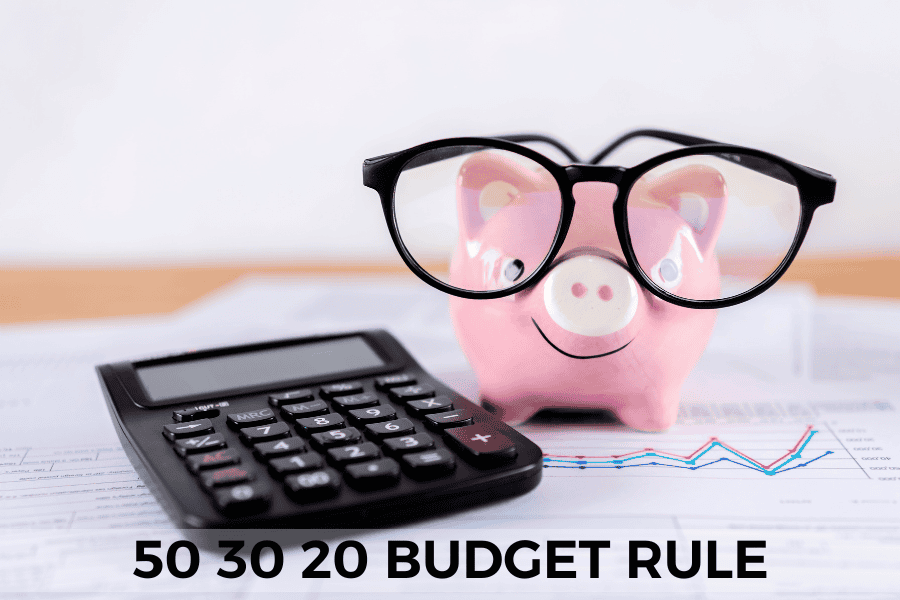Last Updated July 18, 2024 by Davina Kelly
Are you looking for a simple budget plan to help you reach your goals without feeling deprived? The 50 30 20 budget rule can help you do just that.
Managing your finances can often feel overwhelming, especially when you’re trying to balance living expenses, lifestyle choices and saving for the future.
Just thinking about how to balance it all can feel stressful and stop you from getting started.
The 50 30 20 budget rule offers a simple solution to this. It will help you create a budget to balance everything.
Budgeting was daunting for me too at first, but I used this framework to create a budget that worked for me.
It helped me pay off my debt, build up my savings and start investing.
In this post, you’re going to learn what the 50 30 20 budget rule is and how you can implement it to manage your money.
After reading this post, you will have a budget plan to help you work towards your financial goals while still maintaining a lifestyle you enjoy.
This post is all about the 50 30 20 budget rule.
This post may contain affiliate links, which means we will receive a commission if you purchase through our links, at no extra cost to you. Please read full disclosure for more information.
What Is The 50 30 20 Budget Rule?
The 50 30 20 budget rule is a budget strategy that allocates your take-home pay into three broad categories. It was made popular by Sen. Elizabeth Warren in her book All Your Worth: The Ultimate Lifetime Money Plan.
Here are the categories.
- Needs
- Wants
- Savings & Debt repayment
That’s it. It’s super simple and easy to follow.
By working with these three categories you will ensure that your essential needs are covered, you enjoy your life and you make progress towards financial security.
The simplicity of this budget also means that you don’t have to get into the micro details of your spending. Instead of breaking down your budget into different expense categories you can just focus on staying within the limits of the overall categories.
Tracking your expenses and receipts can be tedious. Trying to figure out where every dollar went can be stressful and it can put some people off from budgeting.
But this budget rule offers an easy solution for people to manage their money and reach their financial goals.
Now that you know what the 50 30 20 budget rule is, let’s get into the steps on how to put your budget together.
How To Manage Your Money With The 50 30 20 Budget Rule:
Step 1: Calculate Your Monthly Income
As with any budget, the first step is to determine your monthly post-tax income. This is the money you receive after all of your deductions such as taxes, social security and retirement contributions.
Identify your income sources. This includes your salary, side hustles, freelance work and any other income streams.
You can check your previous payslips to find the net income for your salary. For your side hustle earnings, if you make different amounts each month you can use an average.
For example, if you make $500 in January, $800 in February and $950 in March you can add the total amount and divide it by three to get the average. In this case, you would include $750.
To give you a practical example let’s say your monthly income is $4,000. This is made up of your salary of $3,250 + $750 side hustle income. I will use this number to calculate your budget amounts for each category.
Once you know how much money you have to work with, you’re ready to allocate your money according to the 50 30 20 budget rule.
You can use the free budget printable I have included below to put it all together.
Step 2: Budget 50% For Needs
According to this simple budget rule, 50% of your income should be used to cover your needs. These are the essential expenses you must cover to maintain your standard of living.
These include expenses such as:
- Housing (rent or mortgage)
- Utilities (electricity, water, heating)
- Food (weekly groceries)
- Transportation (car payments, car insurance, public transport)
- Insurance (health, dental, auto, life, home)
- Minimum debt repayments (credit cards, loans)
50% of $4,000 = $2,000 so this is the amount we will be allocating to this category.
This is the biggest chunk of your budget so it is important to ensure all of your expenses in this category are needs and not wants. You also want to ensure you’re spending as efficiently as possible.
For example, if you’re spending a lot of money on food can you find ways to cut back? Be honest with yourself, are you buying more groceries than you need? Are you eating takeaways more often than you should?
Food is one of the top three highest household expenses so if you can find ways to cut back in this area you will save yourself a lot of money. This is the first area I focused on when I started budgeting and it has saved me hundreds every month.
Ways To Cut Back
You can save money on food by planning your meals for the week and doing weekly grocery shopping. This will save you time and relieve you from the stress of thinking about what to eat after a long busy day.
If you don’t enjoy meal planning or you simply don’t have the time, then I recommend you give the $5 Meal Plan a try.
For just $5 a month, you will receive delicious meal plans and grocery lists straight to your inbox every week. And the great thing is each meal costs less than $3 so this will really help you save money on food.
You can try it completely free here for 14 days. If you don’t like it you can cancel at any time with no problems.
Another area you can focus on is your utilities. Sometimes we just accept the offer we have been given. But if you check price comparison sites or negotiate with your service provider you can get a better deal. I use this website to find the best deals in my area.
Go through your expenses in this category and see if you can find ways to cut back and eliminate anything that isn’t essential.
Step 3: Budget 30% For Wants
This part of your budget is where you allocate 30% to wants aka fun. For a monthly net income of $4,000, the allocation for wants would be $1,200 which is very generous lol
You have the freedom to spend money on anything you want. This can include things like:
- Shopping
- Daily coffee
- Vacations
- Dinners with friends
- Movies
- Monthly subscriptions (gym membership, Netflix, Amazon Prime, etc)
You deserve to enjoy the fruits of your labour so don’t be shy, spend some money on things you enjoy.
Although you have the flexibility to spend on whatever you want, these expenses can add up fast. You may not be able to afford everything on your list so I recommend focusing on the things that are valuable to you and make you happy.
You shouldn’t feel guilty for treating yourself to a massage. The whole point of budgeting is to manage your money in a way that works for you. So if you focus on mindful spending you can spend with intention and stick to your budget without feeling restricted.
Some other ways to manage your wants are booking activities in advance to give yourself more time to put money aside.
Or you can become a savvy spender and look for deals. For example, if you want to book a spa day you can look on websites like lastminute.com to find discounts.
By having a category in your budget dedicated to fun you’re more likely to stick to it. This will make it easier to achieve your financial goals.
Step 4: Budget 20% For Saving & Debt Repayment
The final 20% of your income should be dedicated to building your savings and paying off debts. For a monthly net income of $4,000, the allocation would be $800.
Your savings and debt repayment categories can include
- Savings (emergency funds & large purchases such as a home or car)
- Retirement savings (401k, IRA, Pensions etc)
- Investments (stock and shares)
- Debt repayments over the minimum balance (student loan, car loan, credit card etc)
This category is crucial for long-term financial health and planning for your future. You should prioritise which items you focus on in this category based on your current financial situation.
For example, if you don’t have any savings you should focus on building an emergency fund. Or if you have a lot of consumer debt like credit cards and car loans you should prioritise paying that debt down.
On the other hand, if you don’t have any debt and have built a cushy emergency fund you might be ready to start investing and growing your money. You get the point, focus on the next right step for you and your finances.

Whichever stage you’re at here are some practical tips to help you.
Build An Emergency Fund
Aim to save one month’s living expenses minimum (your needs). It is ideal to have three to six months saved up, but if you can only afford one that is better than nothing.
I recommend including a buffer for any unexpected costs to be safe. You don’t want to be hit with an unexpected car repair and be stressing about how to pay for it. If we stick with the monthly income example I used that would be a $3,000 minimum emergency fund ($2,000 for needs plus a $1,000 buffer).
Automate Savings
Having your savings set up on autopilot will take the guesswork out and ensure you stay consistent. So decide a realistic amount you can commit to saving each month and set up a transfer from your current account every payday.
Use High-Interest Savings Accounts
If you leave your money sitting in a regular savings account it will lose buying power due to inflation. This simply means your money will have less value because the prices of everything from groceries to petrol are increasing.
To combat this you can put your savings in a high-interest savings account. This will allow you to earn interest on your savings and increase the value.
Invest
If you’re ready to build wealth you can start investing your money. Investing in index funds is a great way to begin. This is a good option if you’re a beginner because they are low risk, diversified, and the fees are low.
You can read this post to learn how to invest in index funds step by step. This will allow you to start building wealth and make passive income.
Please note this strategy is only recommended if you have built your emergency fund.
Step 5: Review Your Progress
Once you have put everything in place to manage your money using the 50 30 20 budget rule the hard work is done. But it is important to review your progress.
Reviewing your budget regularly is essential to ensure you’re on track to reach your goals. It’s also a great way to see if everything is working and make any necessary adjustments.
Once a month you can review your budget and compare your actual spending to your budget amounts. I usually do this within the first week of the following month. Once you have everything set up it will take you less than half an hour.
If you have overspent in any categories try to understand why it happened and make adjustments. For example, if you have spent more than you budgeted on transportation because the petrol and transit costs have gone up you can increase the budget amount and look for ways to cut back in another area.
Is 50 30 20 Rule Good?
The 50 30 20 budget rule is a great option if you are new to budgeting. It is easy to follow, it includes all the important categories and it allows you to spend money on yourself while working towards your goals.
It is also a great option if you don’t want to get into the micro numbers and enjoy flexibility.
This budget serves as a baseline but as with all budgets I recommend tweaking it to make it work for you. I think it is a good rule of thumb, but if I were to use this budget method I would make one adjustment.
I would allocate 30% to savings and investments and 20% to wants. As you saw with the monthly income amount I used as an example you would have spent $1,200 on wants and put $800 towards savings and debt repayments.
While I am all for spending money on fun and I understand the reasoning, I think contributing $1,200 towards your future is a more sensible approach.
Personal finance is personal and your budget should reflect your goals and your lifestyle. So use this budget rule as a guideline and adjust it to work for you.
Frequently Asked Questions About 50 30 20 Budget Rule
Below are answers to some common questions about the 50 30 20 budget rule.
How Do You Stick To a 50 30 20 Budget?
The best way to stick to the 50 30 20 budget is to make it work for you. This budget rule gives you a baseline to work with. But you should adjust it according to your needs.
For example, you may have a lot of debt you want to pay off so your budget may look something like 50 20 30. Once you have paid off your debt you can reassess and adjust the split as necessary.
How To Save Money When You Are Broke?
When you are broke it can be challenging to save money. It can feel like you are just about getting by so saving seem’s impossible. But there are still some ways to save money when you’re broke.
You can cut back on your essential expenses. The highest household expenses are housing, food and transportation so you can look at ways to save money in these areas.
For example, you can look for ways to save money on groceries. Once you have cut back and released money in your budget you can put it towards savings. Even if it is only $100 a month saving a small amount consistently will add up over time.
Final Thoughts
The 50 30 20 budget rule is a practical approach to managing your finances. It will ensure that you cover your essential needs enjoy your life and still make progress towards your goals.
By calculating your monthly income, allocating your budget effectively and regularly reviewing your progress you can achieve financial stability and peace of mind.
This budget provides a good starting point and you can adapt it to fit your lifestyle and goals making it a good option for anyone who wants to improve their financial health.
I hope you have found this post helpful and now understand how the 50 30 20 budget rule works. How are you getting on with your budget? Let me know in the comments below.
This post was all about the 50 30 20 budget rule.
Other Posts You May Like:
The 60 30 10 Rule Budget Explained & How To Use It
How To Stop Living Paycheck To Paycheck & Skyrocket Your Savings (13 Easy Steps)
15 Easy Money Management Tips For Beginners (Improve Your Finances)

Davina Kelly
Hey! I'm Davina, the owner of Davinas Finance Corner. I'm passionate about finding ways to budget, save, earn more money and improve your life. After breaking free from payday loan debt and living paycheck to paycheck I want to share my experience to help other women improve their finances.
